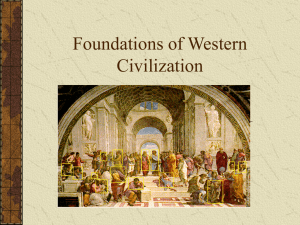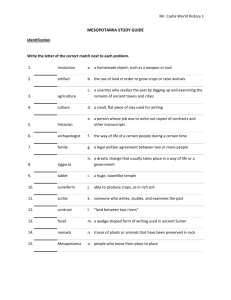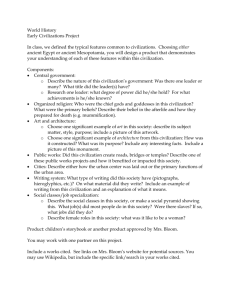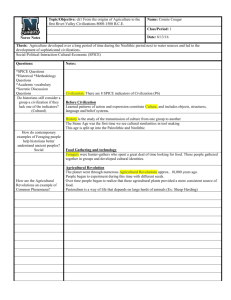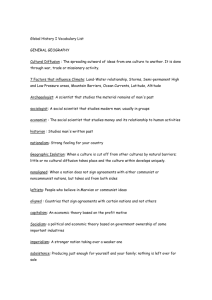Prehistoric and Ancient History - Lakeland Central School District
advertisement
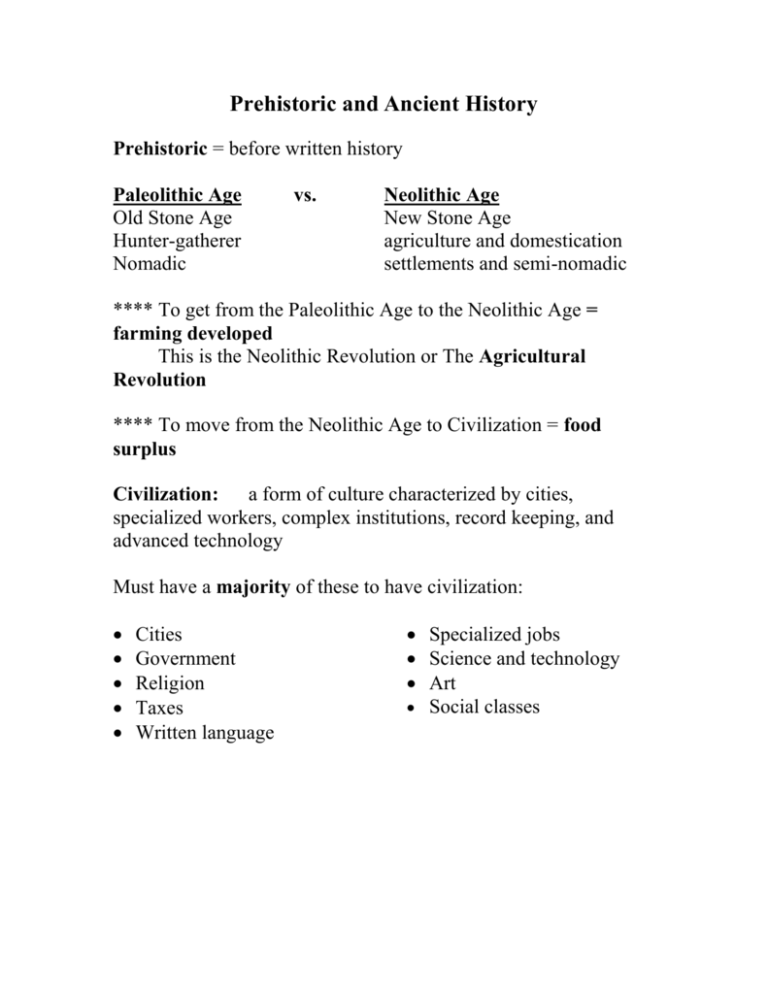
Prehistoric and Ancient History Prehistoric = before written history Paleolithic Age Old Stone Age Hunter-gatherer Nomadic vs. Neolithic Age New Stone Age agriculture and domestication settlements and semi-nomadic **** To get from the Paleolithic Age to the Neolithic Age = farming developed This is the Neolithic Revolution or The Agricultural Revolution **** To move from the Neolithic Age to Civilization = food surplus Civilization: a form of culture characterized by cities, specialized workers, complex institutions, record keeping, and advanced technology Must have a majority of these to have civilization: Cities Government Religion Taxes Written language Specialized jobs Science and technology Art Social classes I. A. B. Ancient River Valley Civilizations Tigris and Euphrates River Valley 1. Geographical Issues: a. unpredictable flooding b. no natural barriers = constant invading c. access to water = trade 2. Mesopotamia = land between two rivers 3. Modern day Iraq 4. Part of the Fertile Crescent 5. Evidence of Civilization a. cities: Ur, Babylon, Akkad, Sumer, city-states b. gov’t: Code of Hammurabi = king’s laws “eye for an eye” c. religion: polytheism, ziggurats d. written language: cuneiform e. specialized jobs: scribes, priest, farmers, artists f. science and technology: irrigation, wheel, sail, plow Nile River Valley 1. Geographical issues a. floods predictably = growing seasons and calendar b. river floods, river recedes, fertile soil (SILT) left behind c. delta region at mouth of river d. papyrus plant becomes paper e. access to Mediterranean Sea + Red Sea = trade f. cataracts = steep cliffs along river 2. North Africa = modern day Egypt 3. Evidence of Civilization a. cities: Memphis, Thebes b. gov’t: theocracy, pharaoh c. religion: priests, after life, mummification, polytheism, d. written language: hieroglyphics e. science and technology: mummification, pyramids, irrigation, mathematics, geometry, medicine C. Indus River Valley 1. Geographical Issues a. unpredictable flooding b. Himalaya Mountains = natural barrier c. Monsoon winds i. wet = warm = summer ii. dry = cold = winter 2. Northern India 3. Evidence of Civilization a. cities: Harappa, Mohenjo-Daro, planned grid cities b. gov’t: social welfare, strong central gov’t c. religion: polytheism, related to Hinduism d. specialized jobs: farming, artisans e. science and technology: plumbing, grid cities, irrigation, sewage system f. written language: not deciphered yet D. Huang He (Yellow) and Yangtze Rivers 1. Geographical issues: a. rivers flood unpredictably b. soil deposited = loess c. on a plain d. natural barriers = Gobi Desert + Himalaya Mts. e. Isolated 2. central China 3. Evidence of Civilization a. cities: Amyang, Ynagzhou, Hao, Luoyang b. gov’t: strong central gov’t, dynasties, Mandate of Heaven, dynastic cycle c. social classes: family more important than individual, man centered, nobles and peasants d. science and technology: porcelain, writing, silk, coined money, cast iron e. religion: ancestor worship, oracle bones II. Other Ancient Civilizations A. Indo-Europeans B. 1. Aryans invade India a. caste system b. lighter skin = higher caste c. blend of culture d. new religion = Hindu i. caste system ii. reincarnation iii. karma and dharma e. Buddhism develops by Siddhartha Guatama i. no classes ii. enlightenment and Nirvana iii. 4 Noble Truths and the 8 Fold Path 2. Hittites a. Anatolia = Modern day Turkey b. Adopt other ideas c. Iron technology d. Chariots Fertile Crescent 1. Phoenicians a. coast of Mediterranean b. seafaring nation c. colonies strung out like beads = day’s journey d. carries of civilization e. purple snail dye f. alphabet “Hooked on Phonics” 2. Minoans a. b. c. d. e. 3. Aegean Sea Isle of Crete Women had higher status Human sacrifice End mysteriously Hebrews a. Palestine Area = Canaan b. Monotheism i. history written = Torah ii. Abraham starts iii. God = Yahweh iv. Covenant c. enslaved in Egypt i. leave Egypt ii. new covenant = 10 commandments d. Kingdom of Israel i. David ii. Solomon e. Babylonian Captivity f. interacted with Empires i. Egyptian ii. Persian iii. Babylonian iv. Greek v. Romans g. Diaspora = Jews spread from Palestine to Eastern Europe. (during Roman Empire)




